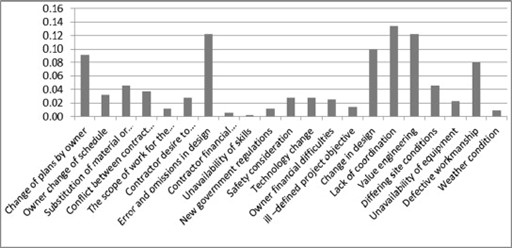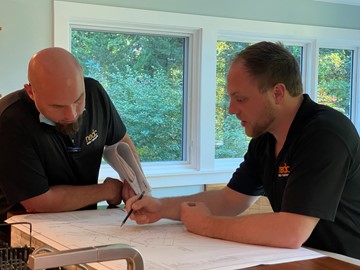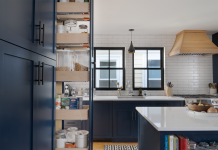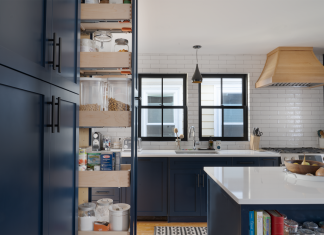Studies show a DesignBuild approach eliminates the top three sources of Change Order costs.

Have you ever remodeled your home and experienced the seemingly endless dismay and frustration of continuous change orders as the project progressed?
Have you experienced a project drag on past its target date several times over…feeling helpless as the project funds slip away seemingly unchecked?
To homeowners experiencing a home remodel, “change orders” can be synonymous with hell.
Having nearly two decades of experience in architecture and construction in Boston and beyond, I wanted to share my viewpoint on the subject in hopes this will help homeowners who might otherwise be adversely affected.
So, how does one avoid such a source of pain, waste and overspend?
We’ll start with clarifying what a change order is.
‘CHANGE ORDER’ DEFINED
The Complete Real Estate Encyclopedia:
“A written order from the owner, architect, engineer, or other authorized person to depart from previously agreed upon plans and specifications for construction. Change order management is a critical aspect of any construction job, as change orders frequently change the cost of the job, usually in an amount in excess of what might otherwise be expected. Many subcontractors bid jobs at break even prices in order to secure the work, confident that numerous change orders will provide the profit necessary.”
So in short, a change order is a change to the plans or scope of work after a contract is signed. It can reduce the extent of work, but typically it increases it, bringing with it higher costs and extended schedules. And incredibly, included within the definition of a change order is the unethical conduct which stems from an artificial divide and lack of responsibility built into the industry.
It is not just subcontractors that partake in this insidious game of change orders, but architects and general contractors, often “separated” yet frequently in cahoots, use the disconnect as a means to facilitate predictable changes and thus the fattening of their pockets. See points a. & b. in this past blog for real world accounts of this lack of transparency and premediated trickery in play. Ashamedly, this is how the rules of the architecture and construction game have been unnaturally set up in the industry today.
It is no wonder the home-improvement industry has ranked second worst for consumer complaints among all sectors by the Consumer Federation of America for eight years in a row! The used-car salesmen and the auto industry are the only sectors who can claim a worse customer satisfaction.
While these complaints focus on residential projects, the notorious reputation of “over budget and off schedule” permeates even the largest commercial building projects. According to a McKinsey & Company study, several types of “large projects” are 80 percent over budget and twenty months off schedule on average! Wow – talk about a CHANGE order.

Potentially avoidable change orders translate to millions of dollars lost and months if not years of lost time.
How can this be?
Are building projects inherently complex and significant change orders unavoidable?
Lets look. A study from the HBCR Journal documents the top causes leading to change orders.
FIVE TOP CAUSES LEADING TO CHANGE ORDERS:

“A list of the greatest causes of change orders were provided to the respondents to choose the top five and then the Importance Index was calculated for each cause.
- Lack of coordination between contractor and consultant
- Error and omissions in design
- Value engineering
- Change in design
- Change of plans by owner”
Amazingly, points 1, 2 and 4 as named above, literally disappear when the architect, general contractor and consultants (such as an interior designer) are one and the same.
This is because the actual source of change order hell in the architecture and construction industry is directly related from the fact that it has been set up to have multiple parties (the architect, builder and sometimes also a separate interior designer) who are all “responsible,” for their portion of the project, but none are fully responsible for the end product. Imagine the food industry set up so you had to hire a recipe writing company and then a cooking company each time you were hungry. Which one would be responsible for the meal? Ridiculous to consider, yet this is what has been set up as the norm in creating a building. This status quo disconnect and a lack of natural integration is the main source of change orders.
I would conservatively estimate an average increase in costs of 20% after construction starts for large-scale residential remodeling projects.
But there is good news in this narrative.
Acting as a case study, NEDC’s average increase in costs after construction commences is under 3% over the past 2 years. On the approximately 10 million dollars’ worth of projects we’ve created in that time, it is a difference of over $1,700,000 saved for our clients when compared with the estimated 20%+ average! When one factors in lost time and stress associated with change orders, the savings are much more.
As an Architectural Design Build firm we act as Architect, Builder and Consultant to our clients so there is no one to blame or point the finger at. There is no sense of “over there.” Any lack of coordination falls on our plate only.
If there is an error, omission or needed change in design, uninitiated by the client, the onus is on us as the single source of accountability–not the client.
If this seems almost too simple—it is.
Our clients are Boston’s best and brightest in their fields and occupied with their businesses, and family lives. Like most homeowners, they are not experts in the design and remodeling process and could easily find themselves caught between an architect and contractor’s change order Rubik Cube. They need and want a process that makes it simple. One that brings transparency and trust into one firm that will be fully responsible for creating incredible spaces that lift their spirits, while providing straightforward prediction on cost and timing.
We have proven that when there is a firm that is a single source of accountability as both the architect AND builder, change orders almost disappear.
So what change orders don’t disappear?
ARE SOME CHANGE ORDERS UNAVOIDABLE?
At NEDC we have a policy that there are only 2 valid change orders – a client-initiated change and an unforeseen existing condition.
While, we will never have a change order for points 1, 2 and 4 above, point 5: “Change of plans by owner”, is a client-initiated change and is not necessarily eliminated with our integrated process. It is more economical and efficient to have the full scope factored for from the start of construction and so we mitigate these type of changes with our thorough design process. Each client knows without a doubt what they are getting and what the finished result will look and feel like. We do this by comparing design options as well as having them see in person, touch and experience all finishes whenever possible. We then create photo-like realistic renderings and/or 3D animation as the final step in our design process. Clients can and sometimes do decide to add scope to an ongoing project that they had previously considered but held off from – the idea of that custom built-in becomes just too much to resist. The key differentiator on this type of change order is that they are in control of the decision.

Giving control to the client relates to the only point left unmentioned – 3. “Value engineering”. Value engineering signifies a reduction in cost from seeking alternative ways to get a similar result, but unfortunately more often comes down to removing the best design features to counterbalance the cost increases from the remaining top 4 causes for change orders. In reality the most efficient time to do value engineering is in the design process, NOT after breaking ground with materials ordered and resources put in motion. I jokingly say our change orders happen in the design process to make the point that this the right time for options to be presented and compared as it is when the client has the most control over this value analysis.
The other valid change orders we have are due to unforeseen existing conditions. This is not listed in this study, as it is referencing only new construction projects where the variability of an existing structure is not present. However, unforeseen existing conditions are a source of change orders in the course of remodeling projects within the older housing stock we have in the Boston area.
I will emphasize that the made for TV surprises you see on HGTV, such as “Oh, this wall IS structural”, should never happen on a project where there is accountability between the design and construction process. Conversely—excellent planning and coordination by our Designers who are each well schooled in building results in plans that are true, sensible and can be executed accurately without surprise. Thus—little to no change orders for unforeseen conditions actually occur in the course of the project.
At NEDC we are responsible for making what might otherwise be considered unforeseen, foreseen through proactive due diligence in our design process. The first of our four design phases entails thorough investigation, including measurements up to a 99.9 degree of accuracy with a laser scanner. We also document the state, size and location of all materials, structure and utilities by looking at what is visible, making small holes when needed to examine behind surfaces with a scope as well as the utilization of an infrared camera and drone.

Our designers, construction team and trade partners collaborate extensively throughout the design process.
This leads back to the true secret of DesignBuild: not simply having the same entity design and build a project from beginning to end— but the process of thinking with, evaluating and setting up a successful build while one is designing. It just so happens that this is far easier and simpler to do if one is the builder.

So I can confidently state that the top 3 budget killers go poof when one embraces the natural approach to creation – DesignBuild!
We seek to create happiness and lasting satisfaction with our Boston clients experiencing a major home design & remodel with an emphasis on sustainable design, effecting positive change, and the stewardship of our Earth. Our DesignBuild process offers thorough and mindful planning leading to a straightforward and smooth build experience.
Many thanks to the sage, Sakib Khan (www.linkedin.com/in/sakibkhan/) for inspiring this blog by sharing one of the studies referenced here, and for his consistent friendship, guidance and wisdom over the years.
Love,
David
Refs:
- https://www.mckinsey.com/industries/capital-projects-and-infrastructure/our-insights/imagining-constructions-digital-future
- https://www.sciencedirect.com/science/article/pii/S1687404813000060
- The Complete Real Estate Encyclopedia by Denise L. Evans, JD & O. William Evans, JD. S.v. “change order.” Retrieved October 24 2021 from https://financial-dictionary.thefreedictionary.com/change+order
- https://consumerfed.org/press_release/nations-top-10-consumer-complaints/
- https://www.linkedin.com/in/sakibkhan/



















